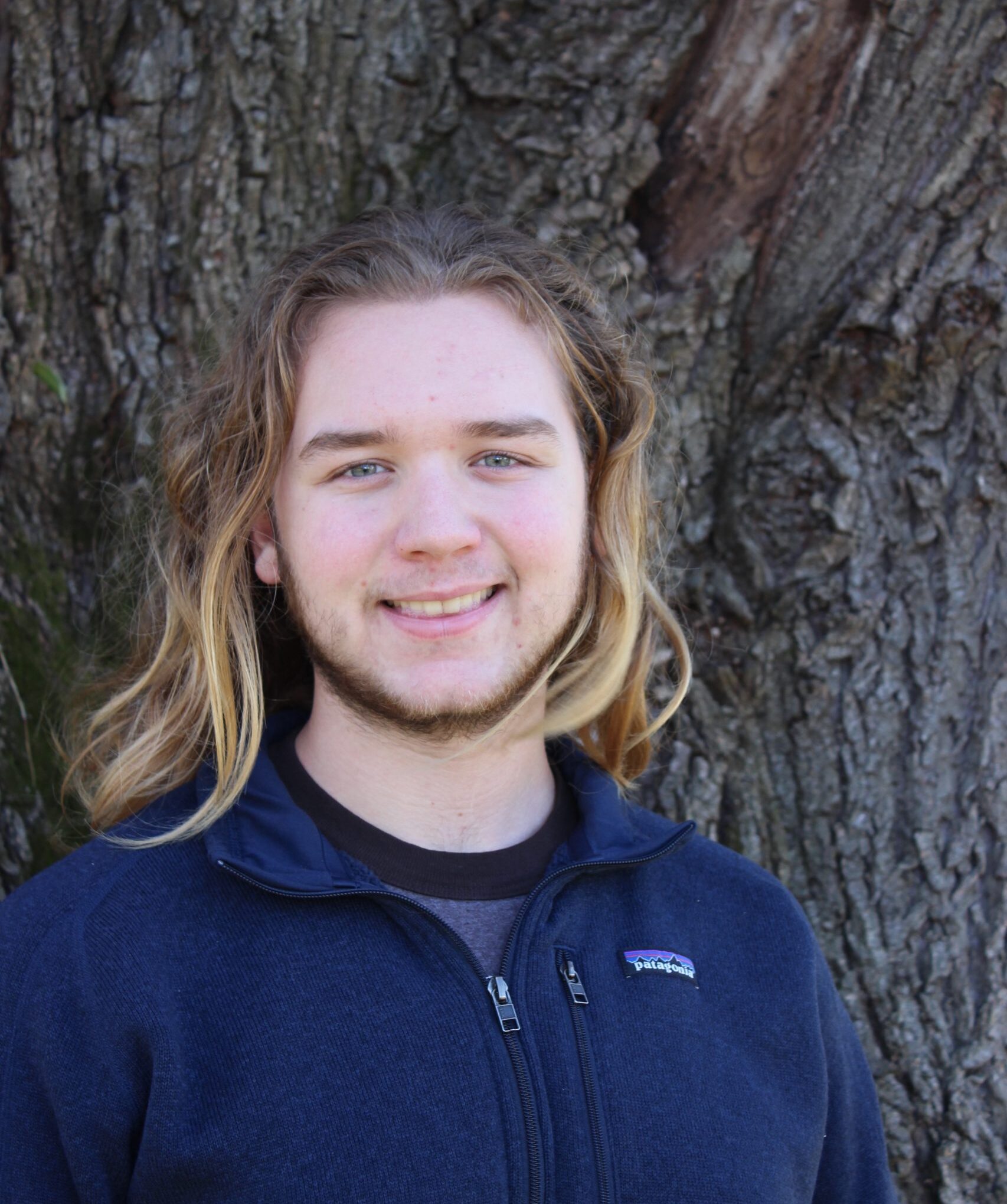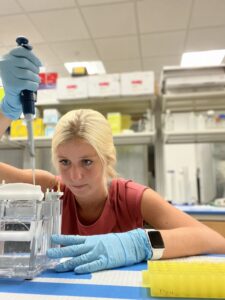 Exposure to radiation causes double-stranded breaks (DSBs) in human DNA, leading to many types of cancers. Humans are at risk of radiation exposure through medical examinations, treatments, nuclear accidents, and space travel. Thus, investigating the effects of radiation-induced DNA damage is important for finding new ways to protect humans from radiation-induced disorders. Last year, I investigated the effects of DSBs on B-Raf, an important signaling protein involved in cell growth and DNA repair pathways using human cancer cells as models. These cells were treated with doxorubicin, a radiomimetic drug (a compound that mimics radiation and creates DSBs in cells).
Exposure to radiation causes double-stranded breaks (DSBs) in human DNA, leading to many types of cancers. Humans are at risk of radiation exposure through medical examinations, treatments, nuclear accidents, and space travel. Thus, investigating the effects of radiation-induced DNA damage is important for finding new ways to protect humans from radiation-induced disorders. Last year, I investigated the effects of DSBs on B-Raf, an important signaling protein involved in cell growth and DNA repair pathways using human cancer cells as models. These cells were treated with doxorubicin, a radiomimetic drug (a compound that mimics radiation and creates DSBs in cells).
My results clearly show a concentration-dependent reduction specifically in the B-Raf protein levels. This decrease in B-Raf levels also correlates with the formation of DSBs in the treated cells. The mechanisms underlying this specific reduction of B-Raf levels due to doxorubicin treatment are unclear. During this scholarship, I intend to analyze the effects of doxorubicin treatment on Ras protein, which is essential for forming functional heterodimers with B-Raf. Additionally, I will also examine the effects of doxorubicin on the levels of B-Raf and Ras mRNA. My studies would shed new light on understanding the effects of DSBs due to radiation exposure, leading to new developments for protection against radiation exposure for astronauts and other space travelers. Additionally, these studies may further improve therapeutic applications of radiomimetic drugs, like doxorubicin, in the treatment of various cancers.



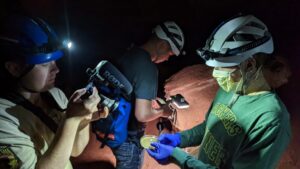 Samples were collected at Wind Cave National Park on multiple different trips. As the team goes deeper and deeper into the cave, the goal is to actively trace the types of microorganisms (fungi, bacteria, and archaea) throughout the cave. The process to obtain genus- and species-level identification of these samples utilizes PCR amplification of different sections of their genomic DNA followed by sequencing analysis. The objective of this project is to make a genetic map of the Wind Cave microbial system that includes public tour routes as well as deep wild cave regions, including previously reported lake extremophiles. This effort will determine how genetically unique or isolated the lake system is and what influence surface microbes and anthropogenic contamination from cave explorers may have had on the subterranean microbiome. An initial phylogenetic tree showing the relatedness of the identified microorganisms is presented. This project is based upon work supported by the Iowa Space Grant Consortium under NASA Award No. 80NSSC20M0107.
Samples were collected at Wind Cave National Park on multiple different trips. As the team goes deeper and deeper into the cave, the goal is to actively trace the types of microorganisms (fungi, bacteria, and archaea) throughout the cave. The process to obtain genus- and species-level identification of these samples utilizes PCR amplification of different sections of their genomic DNA followed by sequencing analysis. The objective of this project is to make a genetic map of the Wind Cave microbial system that includes public tour routes as well as deep wild cave regions, including previously reported lake extremophiles. This effort will determine how genetically unique or isolated the lake system is and what influence surface microbes and anthropogenic contamination from cave explorers may have had on the subterranean microbiome. An initial phylogenetic tree showing the relatedness of the identified microorganisms is presented. This project is based upon work supported by the Iowa Space Grant Consortium under NASA Award No. 80NSSC20M0107.
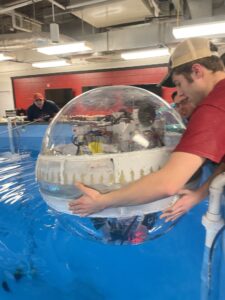 Upon deployment, small satellites can fail to satisfy mission objectives due to the lack of affordable testing equipment for attitude determination and control. The Floating Attitude Control Test System project, known formally as FACTS, Aims to reduce the failure rates of small sat failure upon deployment by providing sub-system level verification for CubeSats. The current FACTS platform can fit up to a 3U size CubeSat and features scalability. The system allows for the center of mass compensation and currently offers three degrees of rotational freedom. The system is currently being improved by verifying system dynamics using a Qualisys motion tracking system to analyze quaternions and spatial rotation to provide useful test documentation. The future for FACTS is to distribute the system as an open-source platform for smaller educators and universities for CubeSat testing and expand the system to fully test attitude control in six degrees of freedom.
Upon deployment, small satellites can fail to satisfy mission objectives due to the lack of affordable testing equipment for attitude determination and control. The Floating Attitude Control Test System project, known formally as FACTS, Aims to reduce the failure rates of small sat failure upon deployment by providing sub-system level verification for CubeSats. The current FACTS platform can fit up to a 3U size CubeSat and features scalability. The system allows for the center of mass compensation and currently offers three degrees of rotational freedom. The system is currently being improved by verifying system dynamics using a Qualisys motion tracking system to analyze quaternions and spatial rotation to provide useful test documentation. The future for FACTS is to distribute the system as an open-source platform for smaller educators and universities for CubeSat testing and expand the system to fully test attitude control in six degrees of freedom.
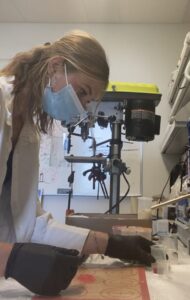 The field of gaseous materials has many far reaching and impactful applications. The ability to deliver gas to a specific area within the body has been shown to have therapeutic properties and can be beneficial for wound healing, improving cancer treatments, and decreasing inflammation. Many current methods for gas entrapment and delivery are inefficient and difficult to administer. Under the supervision of Dr. James Byrne at the University of Iowa, we are working to fabricate a solid, biodegradable implant that has the capability of high-volume gas release. Our goal is to develop a matrix conducive to delivering a variety of gasses in vivo and be able to control the dissolution of the matrix to optimize timing of gas delivery. We are working to evaluate the potential of different biomaterials that form amorphous crystalline arrangements and to alter the properties of the material to control the timing of its dissolution within the body. These innovative devices can be used to store drugs, oxygen, and any other desired material to be delivered to biological systems. They could be extremely useful in expanding the capabilities of human spaceflight exploration and the survival of living systems in space. These devices have the potential to benefit and prolong life on earth as well as enhance and enable future space exploration.
The field of gaseous materials has many far reaching and impactful applications. The ability to deliver gas to a specific area within the body has been shown to have therapeutic properties and can be beneficial for wound healing, improving cancer treatments, and decreasing inflammation. Many current methods for gas entrapment and delivery are inefficient and difficult to administer. Under the supervision of Dr. James Byrne at the University of Iowa, we are working to fabricate a solid, biodegradable implant that has the capability of high-volume gas release. Our goal is to develop a matrix conducive to delivering a variety of gasses in vivo and be able to control the dissolution of the matrix to optimize timing of gas delivery. We are working to evaluate the potential of different biomaterials that form amorphous crystalline arrangements and to alter the properties of the material to control the timing of its dissolution within the body. These innovative devices can be used to store drugs, oxygen, and any other desired material to be delivered to biological systems. They could be extremely useful in expanding the capabilities of human spaceflight exploration and the survival of living systems in space. These devices have the potential to benefit and prolong life on earth as well as enhance and enable future space exploration.
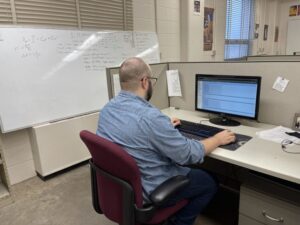 Stellar merger remnants are most often obscured by opaque clouds of gas and dust. TYC 2597-735-1 presents a rare opportunity to observe the post-merger remnant and its surroundings in the near-infrared in order to better understand the impacts stellar mergers have on their systems.
Stellar merger remnants are most often obscured by opaque clouds of gas and dust. TYC 2597-735-1 presents a rare opportunity to observe the post-merger remnant and its surroundings in the near-infrared in order to better understand the impacts stellar mergers have on their systems.
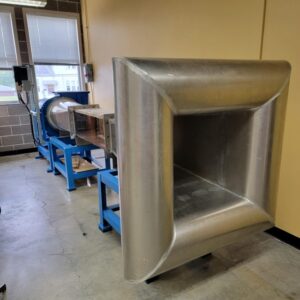 As the aviation industry continues to push forward with greener and more efficient travel, new design concepts are needed to reach the next level of aircraft aerodynamic efficiency. This research aims to conduct external flow analyses for conceptual aircraft over the complete flight envelope of modeled aircraft through CFD methods and wind tunnel testing. The first phase of the research will focus on the applicability of the turbulence models for benchmarked cases of airfoils for which experimental results are already available. Following data validation, the second phase will involve applying the same computational models to a scaled conceptual aircraft configuration to explore improved aerodynamic efficiency, drag reduction, and opportunities for greener propulsion. A scaled version of the aircraft configuration will be 3D printed and subsequently tested using a wind tunnel. The experimental results will be compared to current aircraft to validate advances in the aerodynamic efficiency of the conceptual models.
As the aviation industry continues to push forward with greener and more efficient travel, new design concepts are needed to reach the next level of aircraft aerodynamic efficiency. This research aims to conduct external flow analyses for conceptual aircraft over the complete flight envelope of modeled aircraft through CFD methods and wind tunnel testing. The first phase of the research will focus on the applicability of the turbulence models for benchmarked cases of airfoils for which experimental results are already available. Following data validation, the second phase will involve applying the same computational models to a scaled conceptual aircraft configuration to explore improved aerodynamic efficiency, drag reduction, and opportunities for greener propulsion. A scaled version of the aircraft configuration will be 3D printed and subsequently tested using a wind tunnel. The experimental results will be compared to current aircraft to validate advances in the aerodynamic efficiency of the conceptual models.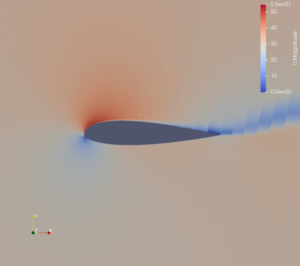
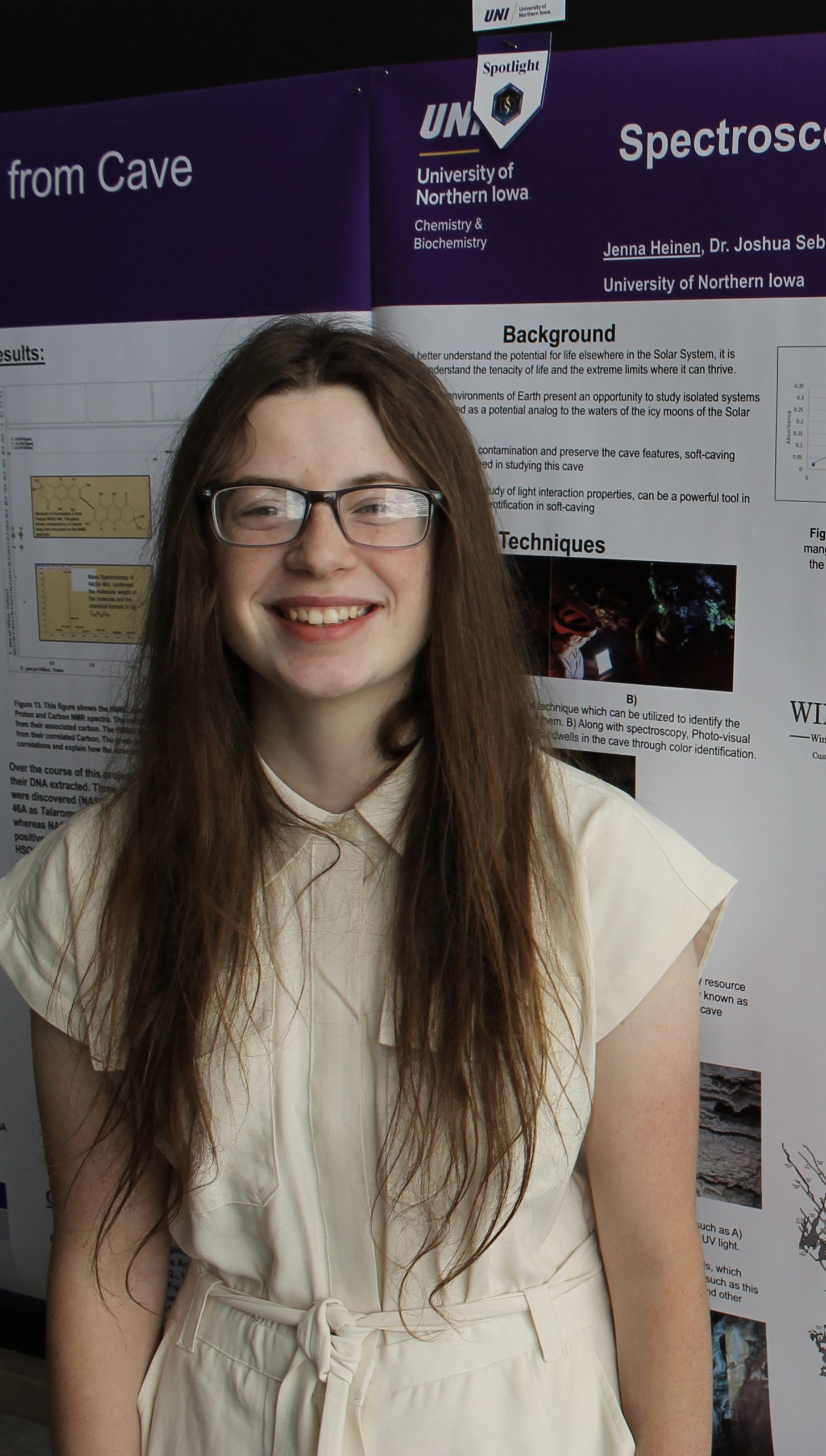
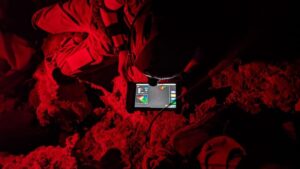 Life in space has been a question plaguing science for many decades. While onsite research is difficult to conduct, due to both the necessary expense and preparation behind it, there are places on Earth which can be used as models to study space’s unique conditions and even its potential for life. In particular, my research advisor, Dr.Joshua Sebree, and I, as well as a group of other researchers at the University of Northern Iowa, have been using Wind Cave National Park as an analog for space, especially in studying the Icy moons of Jupiter and Saturn. With its moderate temperatures (constant 55℉) and high humidity (99%), the environment of the cave, especially around its subterranean lakes, highly resemble the atmospheres of these aforementioned moons.
Life in space has been a question plaguing science for many decades. While onsite research is difficult to conduct, due to both the necessary expense and preparation behind it, there are places on Earth which can be used as models to study space’s unique conditions and even its potential for life. In particular, my research advisor, Dr.Joshua Sebree, and I, as well as a group of other researchers at the University of Northern Iowa, have been using Wind Cave National Park as an analog for space, especially in studying the Icy moons of Jupiter and Saturn. With its moderate temperatures (constant 55℉) and high humidity (99%), the environment of the cave, especially around its subterranean lakes, highly resemble the atmospheres of these aforementioned moons.